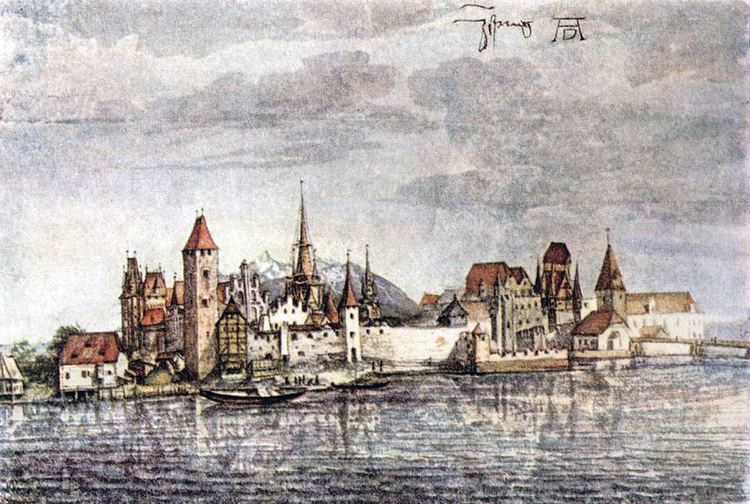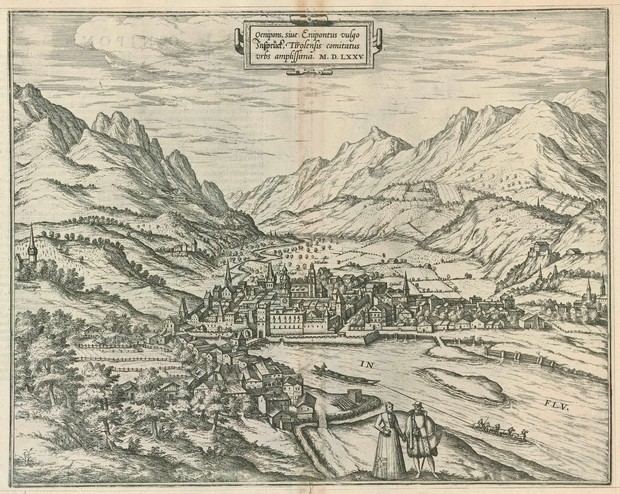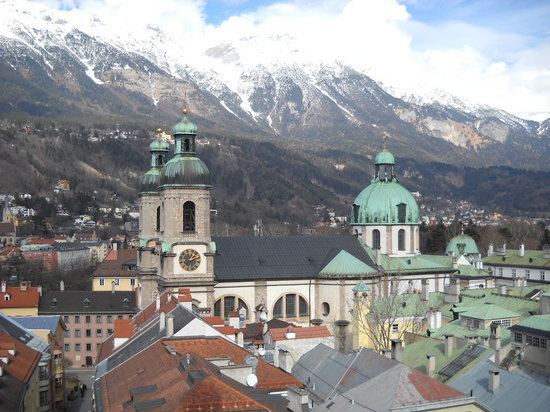Country | Elevation 574 m Area 104.91 km2 District | |
 | ||
Points of interest Goldenes Dachl, Ambras Castle, Hofkirche - Innsbruck, Tyrolean Folk Art Museum, Hofgarten - Innsbruck Colleges and Universities University of Innsbruck, Innsbruck Medical University, MCI Management Center Innsbruck, FH Gesundheit in Innsbruck, Collegium Canisianum | ||
Map of Innsbruck
Innsbruck ( [ˈɪnsbʁʊk], [ˈɪnʃprʊk]) is the capital city of Tyrol in western Austria. It is in the Inn valley, at its junction with the Wipp valley, which provides access to the Brenner Pass some 30 km (18.6 mi) to the south.
Contents
- Map of Innsbruck
- Best places to visit in innsbruck austria
- Visit innsbruck the top 10 sights in innsbruck austria
- History
- Boroughs and statistical divisions
- Climate
- Buildings and monuments
- Museums
- Churches
- Parks and gardens
- Cultural events
- Sports
- Economy and education
- Transport
- Education
- Politics
- Organizations
- Early times to 1600
- 1600 to 1700
- 1700 to 1850
- 1850 to 1880
- 1880 to 1900
- 1900 to 1918
- 1918 to 1930
- 1930 to 1955
- 1955 to modern times
- Twin towns and sister cities
- Partnerships
- Austrian Service Abroad
- References

Located in the broad valley between high mountains, the so-called North Chain in the Karwendel Alps (Hafelekarspitze, 2,334 metres or 7,657 feet) to the north, and the Patscherkofel (2,246 m or 7,369 ft) and Serles (2,718 m or 8,917 ft) to the south.

Innsbruck is an internationally renowned winter sports centre, and hosted the 1964 and 1976 Winter Olympics as well as the 1984 and 1988 Winter Paralympics. Innsbruck also hosted the first Winter Youth Olympics in 2012. The name translates as "Inn bridge".
Best places to visit in innsbruck austria
Visit innsbruck the top 10 sights in innsbruck austria
History
The earliest traces suggest initial inhabitation in the early Stone Age. Surviving pre-Roman place names show that the area has been populated continuously. In the 4th century the Romans established the army station Veldidena (the name survives in today's urban district Wilten) at Oenipons (Innsbruck), to protect the economically important commercial road from Verona-Brenner-Augsburg in their province of Raetia.
The first mention of Innsbruck dates back to the name Oeni Pontum or Oeni Pons which is Latin for bridge (pons) over the Inn (Oenus), which was an important crossing point over the Inn river. The Counts of Andechs acquired the town in 1180. In 1248 the town passed into the hands of the Counts of Tyrol. The city's arms show a bird's-eye view of the Inn bridge, a design used since 1267. The route over the Brenner Pass was then a major transport and communications link between the north and the south, and the easiest route across the Alps. The revenues generated by serving as a transit station enabled the city to flourish.
Innsbruck became the capital of all Tyrol in 1429 and in the 15th century the city became a centre of European politics and culture as Emperor Maximilian I also resided in Innsbruck in the 1490s. The city benefited from the emperor's presence as can be seen for example in the Hofkirche. Here a funeral monument for Maximilian was planned and erected partly by his successors. The ensemble with a cenotaph and the bronze statues of real and mythical ancestors of the Habsburgian emperor are one of the main artistic monuments of Innsbruck. A regular postal service between Innsbruck and Mechelen was established in 1490 by the Thurn-und-Taxis-Post.
In 1564 Ferdinand II, Archduke of Austria received the rulership over Tirol and other Further Austrian possessions administered from Innsbruck up to the 18th century. He had Schloss Ambras built and arranged there his unique Renaissance collections nowadays mainly part of Vienna's Kunsthistorisches Museum. Up to 1665 a stirps of the Habsburgian dynasty ruled in Innsbruck with an independent court. In the 1620s the first opera house north of the Alps was erected in Innsbruck (Dogana).
In 1669 the university was founded. Also as a compensation for the court as Emperor Leopold I again reigned from Vienna and the Tyrolean stirps of the Habsburg dynasty had ended in 1665.
During the Napoleonic Wars Tyrol was ceded to Bavaria, ally of France. Andreas Hofer led a Tyrolean peasant army to victory in the Battles of Bergisel against the combined Bavarian and French forces, and then made Innsbruck the centre of his administration. The combined army later overran the Tyrolean militia army and until 1814 Innsbruck was part of Bavaria. After the Vienna Congress Austrian rule was restored. Until 1918, the town (one of the 4 autonomous towns in Tyrol) was part of the Austrian monarchy (Austria side after the compromise of 1867), head of the district of the same name, one of the 21 Bezirkshauptmannschaften in the Tyrol province.
The Tyrolean hero Andreas Hofer was executed in Mantua; his remains were returned to Innsbruck in 1823 and interred in the Franciscan church.
During World War I, the only recorded action taking place in Innsbruck was near the end of the war. On February 20, 1918, Allied planes flying out of Italy raided Innsbruck, causing casualties among the Austrian troops there. No damage to the town is recorded. In November 1918 Innsbruck and all Tyrol were occupied by the 20-22000 soldiers of the III Corps of the First Italian Army.
In 1929, the first official Austrian Chess Championship was held in Innsbruck.
In 1938 Austria was annexed by Nazi Germany in the Anschluss. Between 1943 and April 1945, Innsbruck experienced twenty-two air raids and suffered heavy damage.
Boroughs and statistical divisions
Innsbruck is divided into nine boroughs (cadastral settlements) that were formed from previously independent municipalities or villages. These nine boroughs are further divided into twenty wards (cadastral districts). All wards are within one borough, except for the ward of Hungerburg (Upper Innsbruck), which is divided between two. For statistical purposes, Innsbruck is further divided into forty-two statistical units (Statistischer Bezirk) and 178 numbered blocks (Zählsprengel).
The following are the nine boroughs with the population as of 31 October 2011:
Climate
As with the rest of Central Europe, Innsbruck has an continental climate (Köppen classification: Dfb/Cfb), although with boreal influences (especially in winter) since it has larger annual temperature differences due to its location in the centre of the Continent and its position around mountainous terrains. Winters are often very cold (colder than those of most major European cities) and snowy, although the foehn wind sometimes brings pronounced thaws.
Spring is brief; days start to get warm, often over 15 °C (59 °F), but nights remain cool or even freezing.
Summer is highly variable and unpredictable. Days can be cool 17 °C (63 °F) and rainy, or sunny and extremely hot, sometimes hitting 34 °C (93 °F). In summer, as expected for an alpine-influenced climate, the diurnal temperature variation is often very high as nights usually remain cool, being 12 °C (54 °F) on average, but sometimes dipping as low as 6 °C (43 °F).
The average annual temperature is 9 °C (48 °F).
Buildings and monuments
Museums
Churches
Parks and gardens
Cultural events
Innsbruck is a very popular tourist destination, organizing the following events every year:
Sports
Due to its location between high mountains, Innsbruck serves as an ideal place for skiing in winter, ski-jumping and mountaineering in summer. There are several ski resorts around Innsbruck, with the Nordkette served by a cable car and additional chair lifts further up. Other ski resorts nearby include Axamer Lizum, Muttereralm, Patscherkofel, Igls, Seefeld, Tulfes and Stubai Valley. The glaciated terrain in the latter makes skiing possible even in summer months.
The Winter Olympic Games were held in Innsbruck twice, first in 1964, then again in 1976, when Colorado voters rejected a bond referendum in 1972 to finance the Denver games, originally awarded in 1970. The 1976 Winter Olympics were the last games held in the German-speaking Alps (Austria, Germany, or Switzerland).
Along with St. Moritz, Switzerland and Lake Placid, New York in the United States, it is one of three places which have twice hosted the Winter Games. It also hosted the 1984 and 1988 Winter Paralympics.
Innsbruck hosted the 1st Winter Youth Olympic Games in 2012.
Innsbruck also hosts one of the 4 ski-jumping competitions of the 4 Hills Tournament every year.
Other notable events held in Innsbruck include the Air & Style Snowboard Contest from 1994 to 1999 and 2008 and the Ice Hockey World Championship in 2005. Together with the city of Seefeld, Innsbruck organized the Winter Universiade in 2005. Innsbruck's Bergiselschanze is one of the hills of the famous Four Hills Tournament.
Innsbruck is home to the football club FC Wacker Innsbruck, which plays in the Austrian Football Bundesliga (first tier) in 2010–11. Former teams include the FC Swarovski Tirol and FC Tirol Innsbruck. FC Wacker Innsbruck's stadium, Tivoli Neu, is one of eight stadiums which hosted Euro 2008 which took place in Switzerland and Austria in June 2008.
The city also hosted an American Football final, Eurobowl XXII between the Swarco Raiders Tirol and the Raiffeisen Vikings Vienna.
The city hosted opening round games in the 2011 IFAF World Championship, the official international American Football championship.
Economy and education
Innsbruck is the cultural and economic centre of western Austria. It is also a substantial tourist centre, with more than a million overnight stays. Innsbruck is a university city, with several locally based colleges and universities.
In Innsbruck, there are 86,186 employees and about 12,038 employers. 7,598 people are self-employed. Nearly 35,000 people commute every day into Innsbruck from the surrounding communities in the area. The unemployment rate for the year 2012 was 4.2%.
The national statistics office, Statistik Austria, does not produce economic data for the City of Innsbruck alone, but on aggregate level with the Innsbruck-Land District summarized as NUTS 3-region Innsbruck. In 2013, GDP per capita in the NUTS 3-region Innsbruck was €41,400 which is around 60% above the EU average.
The headquarters of Tiwag (energy production), Bank für Tirol und Vorarlberg (financial services), Tiroler Versicherung (insurance) and MED-EL (medical devices) are located in Innsbruck. The headquarters of Swarovski (glass), Felder Group (mechanical engineering) and Swarco (traffic technology) are located within 20 km (12 mi) from the city.
Residential property is very expensive by national standards. The average price per square metre in Innsbruck is €4,430 (2015), which is the second highest per square metre price among Austrian cities surpassed only by Salzburg (€4,823), but followed by Vienna (€3,980).
Transport
Innsbruck is located along the A12/A13 highway corridor, providing freeway access to Verona, Italy and Munich, Germany. The A12 and A13 converge near Innsbruck, at which point the A13 terminates.
Innsbruck Hauptbahnhof, the most important railway station of Innsbruck and Tyrol, is one of the busiest railway stations in Austria. It is served by the Lower Inn Valley line to Germany and eastern Austria, the Arlberg line to the west and the Brenner line, which connects northern Italy with southern Germany via the Brenner pass. Since December 2007 suburban services have been operated as the Innsbruck S-Bahn.
Innsbruck Airport is located in the suburb of Kranebitten, which is located in the west of the city. It provides services to airports including Frankfurt, London, Amsterdam and Vienna. It also handles regional flights around the Alps, as well as seasonal flights to other destinations. During the winter, activity increases significantly, due to the high number of skiers travelling to the region. It is the main base of Welcome Air. The airport is approximately 4 kilometres (2.5 mi) from the centre of Innsbruck.
Local public transport is provided by Innsbrucker Verkehrsbetriebe (IVB), a public authority operating a network of bus and tram routes. The metre-gauge tram network consists of two city lines, 1 and 3, and two lines serving the surrounding area: line 6, the Innsbrucker Mittelgebirgsbahn to Igls, and line STB, the Stubaitalbahn running through the Stubai Valley to Fulpmes. The network is planned to be enlarged during the coming years to reach Hall in Tirol in the east and Völs in the west (thus restoring a former tram line [closed in the late 1960s] from Innsbruck to Solbad Hall, as Hall in Tirol was then known). Numerous bus lines serve the inner city and connect it with surrounding areas. Until 2007 the bus network included two trolleybus routes, but these were abandoned in preparation for planned expansion of the tram network.
In December 2007, the Hungerburgbahn, a funicular service to the district of Hungerburg, was reopened after a two-year closure for extensive rebuilding, with partial realignment and a new extension across the Inn River and into central Innsbruck. The line was also equipped with new vehicles. Because of the unique design of the stations, drafted by the famous architect Zaha Hadid, the funiclar evolves immediately to a new emblem of the city. The line was rebuilt by the Italian company Leitner, and can now carry up to 1,200 persons per hour. It is operated by a private company, the 'Innsbrucker Nordkettenbahnen'.
Education
Innsbruck is home to the oldest grammar school (Gymnasium) of Western Austria, the "Akademisches Gymnasium Innsbruck". The school was founded in 1562 by the Jesuit order and was the precursor of the university, founded in 1669.
Innsbruck hosts several universities. The most well-known are the University of Innsbruck (Leopold-Franzens-Universität), the Innsbruck Medical University, and the university of applied sciences MCI Management Center Innsbruck.
Politics
The results of the 2012 local elections were:
Organizations
Early times to 1600
1600 to 1700
1700 to 1850
1850 to 1880
1880 to 1900
1900 to 1918
1918 to 1930
1930 to 1955
1955 to modern times
Twin towns and sister cities
Partnerships
Austrian Service Abroad
The Austrian Service Abroad is a NGO, which provides positions for an alternative Austrian national service at 85 organizations in 35 countries worldwide in the sectors Holocaust Memorial Service, Social Service and Peace Service. It was founded by Andreas Maislinger and Andreas Hörtnagl in 1998 and is based in Innsbruck.
